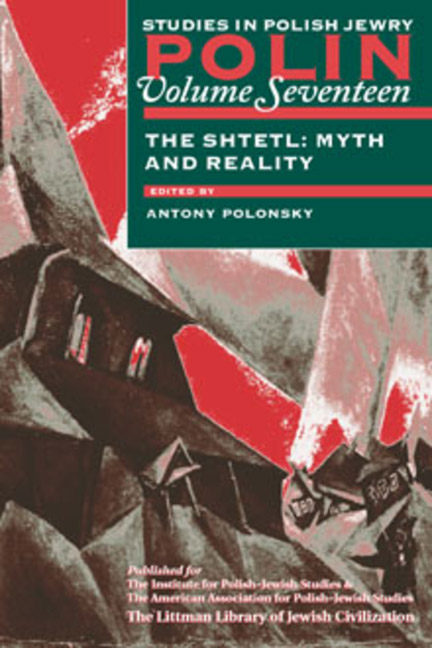Book contents
- Frontmatter
- Dedication
- Editors and Advisers
- Preface
- Polin
- Polin: Studies inPolish Jewry
- Contents
- Note on Place Names
- Note on Transliteration
- List of Abbreviations
- PART I THE SHTETL: MYTH AND REALITY
- Introduction. The Shtetl: Myth and Reality
- The Shtetl as an Arena for Polish–Jewish Integration in the Eighteenth Century
- Inter-Religious Contacts in the Shtetl: Proposals for Future Research
- The Hasidic Conquest of Small-Town Central Poland, 1754–1818
- The Drama of Berdichev: Levi Yitshak and his Town
- Polish Shtetls under Russian Rule, 1772–1914
- How Jewish Was the Shtetl?
- The Changing Shtetl in the Kingdom of Poland during the First World War
- The Shtetl: Cultural Evolution in Small Jewish Towns
- Small Towns in Inter-War Poland
- Jewish Patrons and Polish Clients: Patronage in a Small Galician Town
- Maintaining Borders, Crossing Borders: Social Relationships in the Shtetl
- The Soviet Shtetl in the 1920s
- Shtetl and Shtot in Yiddish Haskalah Drama
- Kazimierz on the Vistula: Polish Literary Portrayals of the Shtetl
- Imagining the Image: Interpretations of the Shtetl in Yiddish Literary Criticism
- Shtetl Codes: Fantasy in the Fiction of Asch, Schulz, and I. B. Singer
- Returning to the Shtetl: Differing Perceptions
- PART II NEW VIEWS
- PART III DOCUMENTS
- PART IV THE SIXTY-FIFTH ANNIVERSARY OF EVENTS IN PRZYTYK: A DEBATE
- PART V REVIEWS
- OBITUARIES
- Notes on the Contributors
- Glossary
- Index
Kazimierz on the Vistula: Polish Literary Portrayals of the Shtetl
from PART I - THE SHTETL: MYTH AND REALITY
- Frontmatter
- Dedication
- Editors and Advisers
- Preface
- Polin
- Polin: Studies inPolish Jewry
- Contents
- Note on Place Names
- Note on Transliteration
- List of Abbreviations
- PART I THE SHTETL: MYTH AND REALITY
- Introduction. The Shtetl: Myth and Reality
- The Shtetl as an Arena for Polish–Jewish Integration in the Eighteenth Century
- Inter-Religious Contacts in the Shtetl: Proposals for Future Research
- The Hasidic Conquest of Small-Town Central Poland, 1754–1818
- The Drama of Berdichev: Levi Yitshak and his Town
- Polish Shtetls under Russian Rule, 1772–1914
- How Jewish Was the Shtetl?
- The Changing Shtetl in the Kingdom of Poland during the First World War
- The Shtetl: Cultural Evolution in Small Jewish Towns
- Small Towns in Inter-War Poland
- Jewish Patrons and Polish Clients: Patronage in a Small Galician Town
- Maintaining Borders, Crossing Borders: Social Relationships in the Shtetl
- The Soviet Shtetl in the 1920s
- Shtetl and Shtot in Yiddish Haskalah Drama
- Kazimierz on the Vistula: Polish Literary Portrayals of the Shtetl
- Imagining the Image: Interpretations of the Shtetl in Yiddish Literary Criticism
- Shtetl Codes: Fantasy in the Fiction of Asch, Schulz, and I. B. Singer
- Returning to the Shtetl: Differing Perceptions
- PART II NEW VIEWS
- PART III DOCUMENTS
- PART IV THE SIXTY-FIFTH ANNIVERSARY OF EVENTS IN PRZYTYK: A DEBATE
- PART V REVIEWS
- OBITUARIES
- Notes on the Contributors
- Glossary
- Index
Summary
IN Polish literature the shtetl has been presented most frequently as a landscape: as the setting for events. It is less often perceived as a community, and more recently it appears as a form of east European Jewish culture.
This pattern can be seen in the literary history of Kazimierz nad Wisłą (Kuzmir). However, in the case of Kazimierz, there were some real and significant reasons for placing landscape at the forefront of representations of the town since it marked the unique character and attractiveness of Kazimierz. The ruins of historic buildings and the hilly landscape—culture and nature—were combined there in an integrated whole of exceptional beauty.
The authors of the entry for Kazimierz in a geographical dictionary of the Polish Kingdom published in 1882 describe the town as follows:
There are probably few towns in Poland that have such a number of curiosities within such a limited area. On the one hand, there are mountains covered with abundant vegetation; on the other, the Vistula flowing just at the foothills of the town. In the middle, the walls of the townhouses and abandoned ruins of old granaries emerge from among the trees. The high church roofs tower above them, while the castle stands even higher. And above the latter, a round, lonely watchtower stands on the highest mountain. All this makes this a landscape worth painting.
The town's picturesque quality and the strong relationship between history and nature found there made Kazimierz an ideal subject for romantic art. As far back as 1841 romantic historicism and a love of ruins began to dominate descriptions of the town. The landscape is presented as both fascinating and mysterious:
A strange sight met my eyes…. I was in the most romantic area…. I found myself among the walls … of an ancient city and it seemed to me that I had gone back to the fourteenth century, to the times of the Peasants’ King [Kazimierz the Great]…. The Gothic crumbling townhouses surrounding the marketplace and the gloomy edifices scattered in the mountains above the town stirred some strange feelings in the soul.
- Type
- Chapter
- Information
- The Shtetl: Myth and Reality , pp. 233 - 242Publisher: Liverpool University PressPrint publication year: 2004

